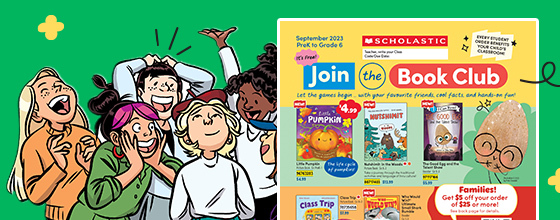Before children are reading, they’re listening and interacting with phonemes — the sounds that make up words. As you and your child establish a read-aloud routine, your gestures, pauses, and questions encourage your child to put those phonemes into words, and ultimately, they recognize those words as language.
Reading is the best way for your child to grow their vocabulary because books are troves of knowledge with unique language that describes the world around us.
“Books contain words that might not be encountered in everyday conversation,” explains Elfrieda Hiebert, PhD, a vocabulary acquisition expert and creator of Scholastic W.O.R.D., a digital vocabulary acquisition and comprehension program. “In books, kids get labels for the world around them. For example, the child may know the word ‘car’ from real-life experience, but in a book they discover ‘vehicle’ as an alternative way to describe things that move with engines.”
Books also introduce children to a spectrum of ideas and allow them to give their full attention to the idea being presented.
“Until you get a plethora of these concepts out in the real world, books are the place that invite you to see things you might not get to see otherwise, like the ocean,” Dr. Hiebert says.
Just like choosing the right read-aloud book for your child, there are many ways you can make the most out of your reading time together. Follow these vocabulary-building techniques from Dr. Hiebert to get started.
1. Choose books with rhymes and easy-to-understand words.
Research points to various milestones for language development. While a child will possess an “expressive” vocabulary of a few words by age 1 (those are words they use, versus “receptive” vocabulary, which are words they understand passively), experts say that by age 4, your child will know about 1,500 words. By age 6, that number doubles.
But instead of focusing on those vocab milestones, Dr. Hiebert suggests paying attention to the richness and quality of the books you read aloud with your child. What you want are books where the language is fun to read, she says.
For example, books with rhymes are a playful way to learn words and understand their context in the story.
“Children express a sense of humour early on,” Dr. Hiebert says. “Seeing that you can have silliness in books is important, too.”
But be careful to avoid books with too little context. Too many unknown words or contrived language — words that rhyme for the sake of it but offer no contextual clues — will make comprehension difficult for your young reader who’s still learning to understand the meaning behind words.
“It’s impossible to decode something if you don’t know what the word is,” Dr. Hiebert says. “It becomes a nonsense exercise.”
2. Read enthusiastically aloud.
Reading aloud to your child sets a strong foundation for loving books and understanding their importance. Plus, dedicating time exclusively to reading gives your child a special place to focus on the content.
“The thing about reading aloud is that it’s a place and time where you actually have the child’s attention, and so you can attend to the meaning of a particular word in a text. Reading aloud both invites kids into what the purpose of reading is and expands their vocabulary,” Dr. Hiebert says.
Listening to an adult read is also really enjoyable for children, just like listening to audiobooks might be soothing for you. So don’t be afraid to take the stage and “perform” your child’s book as you read.
“I’m not a fan of giving kids the opportunity to hear the text they should be reading aloud,” Dr. Hiebert says. “But I am a fan of great readers reading things aloud for you.”
Moreover, reading a book enthusiastically aloud fosters a special bond between you and your child because discoveries are made together. If they see you’re excited about what you’re reading, they’re going to share that same passion for learning.
“Any time a parent is reading to a little kid, there’s comprehension going on,” Dr. Hiebert says. “You both can draw on the same things. You have your own club.”
3. Highlight special words and share their meaning.
Another building block of expanding your child’s vocabulary is understanding that words have multiple meanings — also known as polysemy.
“When you look at an object in real life, it doesn’t morph into something else. But words on a page can,” Dr. Hiebert says.
Because of these nuances in language, a large part of expanding your child’s vocabulary through reading is showing kids where you’re getting the message from.
“You want to do some tracking of the print,” Dr. Hiebert recommends. Seeing the word, sounding it out, and pointing to it when it reoccurs on the page are actions that go a long way toward your child’s understanding of how words are used and what they mean.
Plus, children enjoy sounding words out! Dr. Hiebert notes that young kids are attracted to long words and suggests this is one reason they like dinosaur books.
“When you’re reading to 3- to 5-year-olds, you might point to a word and say, ‘That’s a really interesting word isn’t it?’” she says. “Highlight particular words — you want your finger to hop to it several times to help create phonetic awareness.”
As your child grows, you’ll track text to show “that we express particular ideas by compounding words or putting endings or prefixes on words,” Dr. Hiebert says.
4. Collect new words to look up later.
Books contain three rare words for every 100, Dr. Hiebert says, underscoring her point that many of the words found in books are not used in everyday conversation. So by reading more books, your child collects new words to add to their vocabulary.
For example, a character can “galumph,” “prance,” or “skip.”
“And a lot of those words only appear once in a book,” she says. “That’s why collecting words can be fun.”
Dr. Hiebert recommends collecting words for beginner readers who are transitioning into more independent reading. Your child might keep a journal where they record interesting words or words they don’t know (and what they mean).
“Children are not getting a lot of guidance with how to attend to words with multiple syllables. That’s a place where you can start to collect interesting words,” Dr. Hiebert says.
5. Encourage re-reading books.
Reading the same books might seem like your child isn’t interested in learning new topics and ideas, but it’s actually the opposite, Dr. Hiebert says.
“Kids go through a phase where they read something over and over,” she says. “This is an important stage of development where they’re seeing the permanence of print. They see that language again and again and they memorize it.”
Ultimately, your child gains their reading independence through an affinity for words, which leads to learning more words. Much like discovering nonfiction, the ability to comprehend new information is easier when you have a bigger background to draw on.
“Remember that what you know about a topic is the best predictor of how well you’re going to comprehend something related to it,” Dr. Hiebert says. “The richness of one’s vocabulary is also going to influence how one accesses words as they read on.”
Shop books for building vocabulary at any age below to get started! You can find all books and activities at Scholastic Book Clubs.
Originally published by Scholastic Parents on January 20, 2022. Versioned for Scholastic Canada.
 Book Clubs
Book Clubs
Scholastic Book Clubs helps kids discover the joy of reading. Together, we put can’t-miss books into kids’ hands—at can’t-miss prices, while also giving back to a teacher's classroom!
Visit us online Book Fairs
Book Fairs
Bookjoy or bust! Millions of children have discovered books—and a lifelong love of reading—at a Scholastic Book Fair.
Visit our site